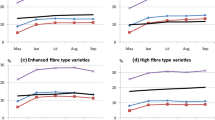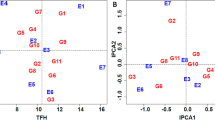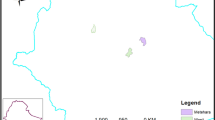Abstract
The aim of this study was to identify the traits that most affect production of sugarcane, fiber and lignin content (LIG) with a view toward optimizing the process of assessment and selection of families of energy cane. Fifty full-sibs families were assessed using an incomplete-block design, with five replications. The traits assessed were mean stalk height (SH), mean stalk diameter (SD), mean number of stalks per plant (NS), mean stalk weight (SW), fiber content (FIB), LIG, tons of cane per hectare (TCH), tons of fiber per hectare (TFH) and tons of lignin per hectare (TLH). Based on path analysis, it was possible to observe that the traits SW and NS, in that order, exhibited the greatest direct effects on TCH, TFH, and TLH. These traits they were indirectly affected to a greater degree by NS. The direct effects of FIB, LIG, SH, and SD on TCH, TFH, and TLH were smaller than the residual effects on the analyses carried out, showing their little importance in the selection process. The increase of TFH and TLH mainly occur due to greater biomass production, which is associated with greater tillering capacity and with the SW of the families. Thus, selection of families with greater FIB might not show genetic gains if the mean values for TCH of their offsprings are low. Therefore, selection of the best families for energy cane should be carried out based on TCH, which may be estimated by way of NS and SW.



Similar content being viewed by others
References
Amarasekara AS (2014) Handbook of cellulosic ethanol. Scrivener Publishing, Texas
Barbosa MHP, Silveira LCI (2012) Breeding and cultivar recommendations. In: Santos F, Borém A, Caldas C (eds) Sugarcane: bioenergy, sugar and ethanol—technology and prospects. Suprema, Viçosa, pp 301–318
Brasileiro BP, Peternelli LA, Barbosa MHP (2013) Consistency of the results of path analysis among sugarcane experiments. Crop Breed Appl Biotechnol 13:113–119
Capaz RS, Carvalho VSB, Nogueira LAH (2013) Impact of mechanization and previous burning reduction on GHG emissions of sugarcane harvesting operations in Brazil. Appl Energy 102:220–228
Cardona CA, Quintero JA, Paz IC (2010) Production of bioethanol from sugarcane bagasse: status and perspectives. Bioresour Technol 101:4754–4766
Carvalho-Netto OV, Bressiani JA, Soriano HL, Fiori CS, Santos JM, Barbosa GVS, Xavier MA, Landell MGA, Pereira GAG (2014) The potential of the energy cane as the main biomass crop for the cellulosic industry. Chem Biol Technol Agric 1:1–8
Dal-Bianco M, Carneiro MS, Hotta CT, Chapola RG, Hoffmann HP, Garcia AAF, Souza GM (2012) Sugarcane improvement: how far can we go? Curr Opin Biotechnol 23:265–270
Dias MOS, Junqueira TL, Cavalett O, Cunha MP, Jesus CDF, Mantelatto PE, Rossell CEV, Filho RM, Bonomi A (2013) Cogeneration in integrated first and second generation ethanol from sugarcane. Chem Eng Res Des 91:1411–1417
FAO (2013) Statistical yearbook 2013—world food and agriculture. http://www.fao.org/docrep/018/i3107e/i3107e00.htm
Gibbons WR, Hughes SR (2009) Integrated biorefineries with engineered microbes and high-value co-products for profitable biofuels production. In Vitro Cell Dev Biol—Plant 45:218–228
Ho DP, Ngo HH, Guo W (2014) A mini review on renewable sources for biofuel. Bioresource Technol 169:742–749
Hofsetz K, Silva MA (2012) Brazilian sugarcane bagasse: energy and non-energy consumption. Biomass Bioenergy 46:564–573
Kang MS, Sosa O, Miller JD (1989) Path analysis for percent fibre, cane and sugar yield in sugarcane. Crop Sci 29:1481–1483
Kimbeng CA, Cox MC (2003) Early generation selection of sugarcane families and clones in Australia: a review. J Am Soc Sugarcane Technol 23:20–39
Lingle SE, Johnson RM, Tew TL, Viator RP (2010) Changes in juice quality and sugarcane yield with recurrent selection for sucrose. Field Crop Res 118:152–157
Loureiro ME, Barbosa MHP, Lopes FJF, Silvério FO (2011) Sugarcane breeding and selection for more efficient biomass conversion in cellulosic ethanol. In: Buckeridge MS, Goldman GH (eds) Routes to cellulosic ethanol. Springer, New York, pp 199–239
Matsuoka S, Bressiani J, Maccheroni W, Fouto I (2012) Sugarcane bioenergy. In: Santos F, Borém A, Caldas C (eds) Sugarcane: Bioenergy, sugar and ethanol - technology and prospects. Suprema, Viçosa, pp 471–500
Ming R, Moore PH, D`Hont A, Glaszmann JC, Tew TL, Mirkov TE, Silva J, Jifon J, Rai M, Schell RJ, Brumbley SM, Lakshmanan P, Comstock JC, Paterson AH (2006) Sugarcane improvement through breeding and biotechnology. In: Janick J (ed) Plant breeding reviews. Wiley, New York, pp 15–118
Montgomery DC, Peck EA (1992) Introduction to linear regression analyses. Wiley, New York, p 504p
R Development Core Team (2014) R: A language and environment for statistical computing. R Foundation for Statistical Computing, Vienna, Austria. ISBN 3-900051-07-0, URL http://www.R-project.org
Rabelo SC, Carrere H, Filho RM, Costa AC (2011) Production of bioethanol, methane and heat from sugarcane bagasse in a biorefinery concept. Bioresour Technol 102:7887–7895
Resende MDV (2007) Software SELEGEN-REML/BLUP: sistema estatístico e seleção genética computadorizada via modelos lineares mistos. Embrapa Florestas, Colombo
Resende MDV, Barbosa MHP (2006) Selection via simulated Blup based on family genotypic effects in sugarcane. Pesq Agropec Bras 41:421–429
Rubin EM (2008) Genomics of cellulosic biofuels. Nature 454(Suppl 14):841–845
Seabra JEA, Tao L, Chum HL, Macedo IC (2010) A techno-economic evaluation of the effects of centralized cellulosic ethanol and co-products refinery options with sugarcane mill clustering. Biomass Bioenergy 34:1065–1078
Silva PP, Soares L, Costa JG, Viana LS, Andrade JCF, Gonçalves ER, Santos JM, Barbosa GVS, Nascimento VX, Todaro AR, Riffel A, Grossi-de-Sa MF, Barbosa MHP, Sant’ana AEG, Neto CER (2012) Path analysis for selection of drought tolerant sugarcane genotypes through physiological components. Ind Crop Prod 37:11–19
Simmonds NW (1996) Family selection in plant breeding. Euphytica 90:201–208
Singh B, Singh S, Pal R (1994) Direct and indirect effects of characters affecting cane yield of five sugarcane crosses. Crop Res 8:302–304
Stringer JK, Cox MC, Atkin FC, Wei X, Hogarth DM (2011) Family selection improves the efficiency and effectiveness of selecting original seedlings and parents. Sugar Tech 13:36–41
Sukhchain SD, Saini GS (1997) Inter-relationships among cane yield and commercial cane sugar and their component traits in autumn plant crop of sugarcane. Euphytica 95:109–114
Tew TL, Cobill RM (2008) Genetic improvement of sugarcane (Saccharum spp.) as an energy crop. In: Vermerris W (ed) Genetic improvement of bioenergy crops. Springer, New York, pp 273–294
Tyagi AP, Lal P (2007) Correlation and path coefficient analysis in sugarcane. S Pac J Nat Sci 25:1–9
Waclawovsky AJ, Sato PM, Lembke CG, Moore PH, Souza GM (2010) Sugarcane for bioenergy production: an assessment of yield and regulation of sucrose content. Plant Biotechnol J 8:263–276
Zeni Neto H, Daros E, Bespalhok Filho JC, Scapim CA, Vidigal MCG, Vidigal Filho OS (2013) Selection of families and parents of sugarcane (Saccharum spp.) through mixed models by joint analysis of two harvests. Euphytica 193:391–408
Author information
Authors and Affiliations
Corresponding author
Rights and permissions
About this article
Cite this article
da Silveira, L.C.I., Brasileiro, B.P., Kist, V. et al. Selection strategy in families of energy cane based on biomass production and quality traits. Euphytica 204, 443–455 (2015). https://doi.org/10.1007/s10681-015-1364-9
Received:
Accepted:
Published:
Issue Date:
DOI: https://doi.org/10.1007/s10681-015-1364-9




